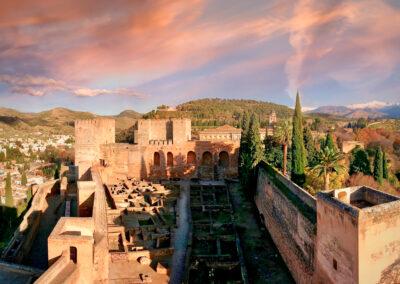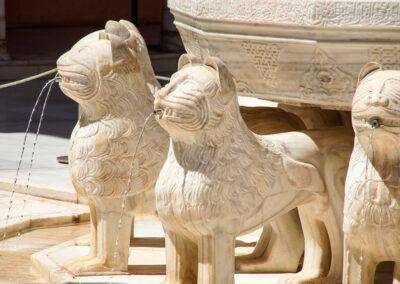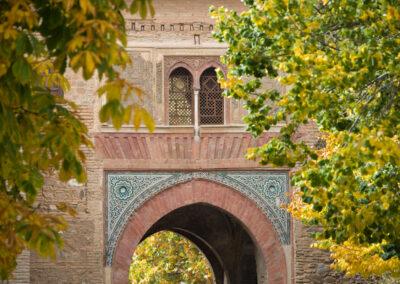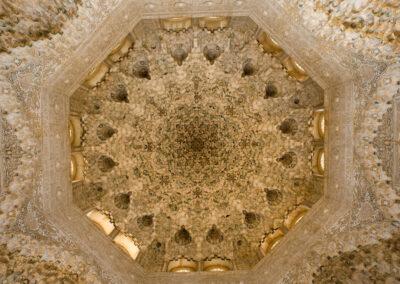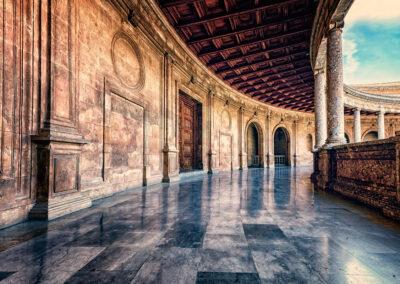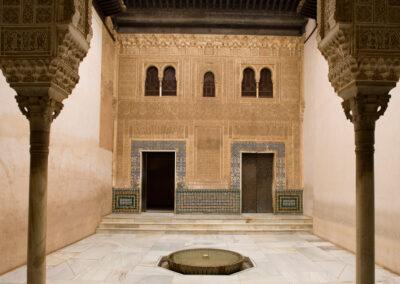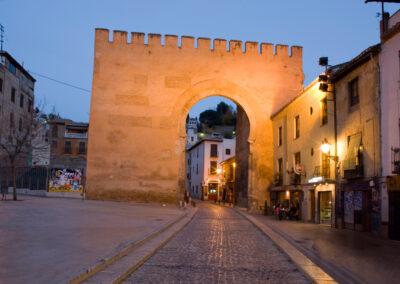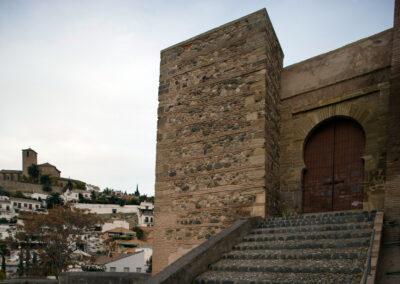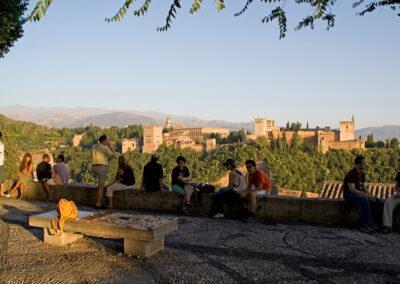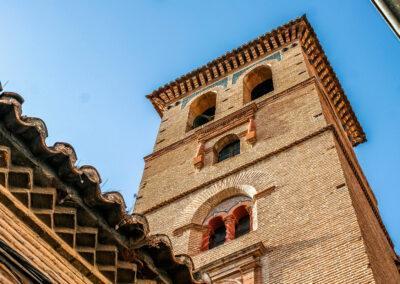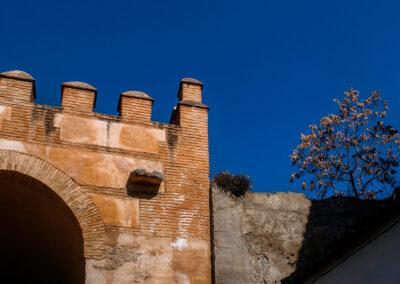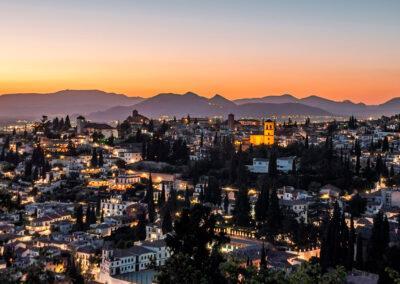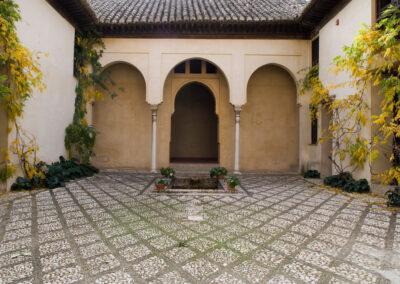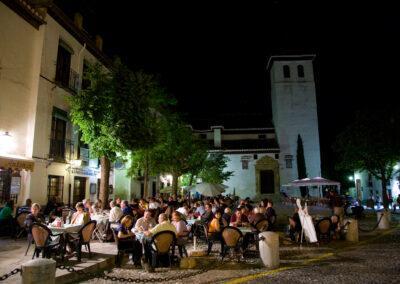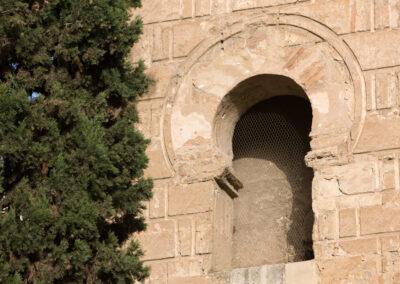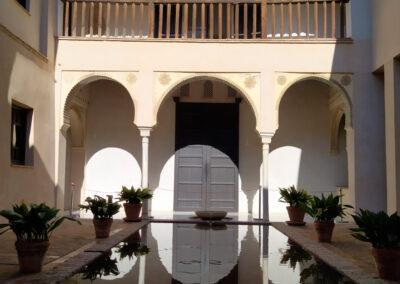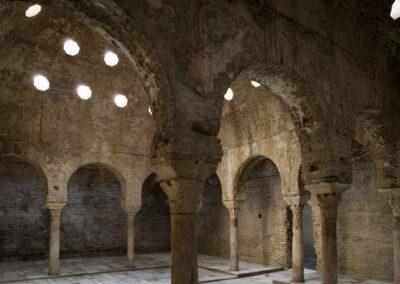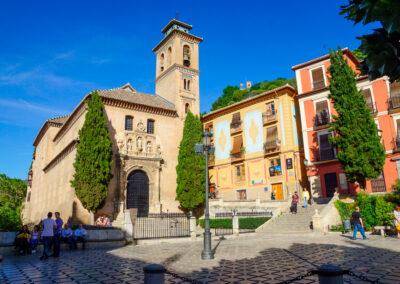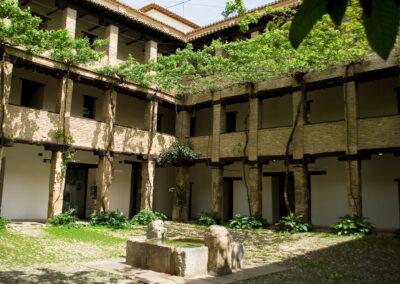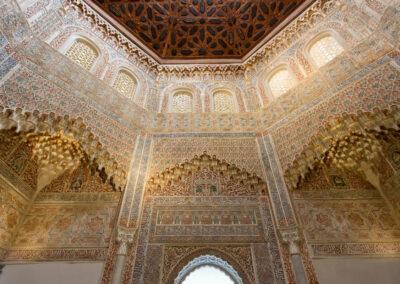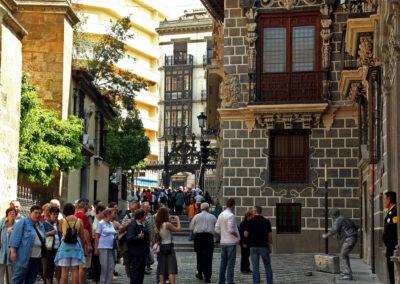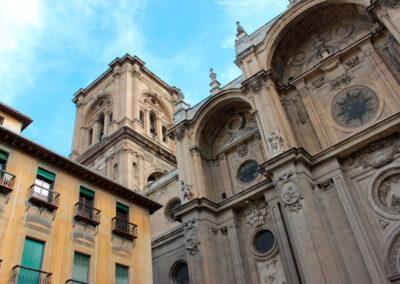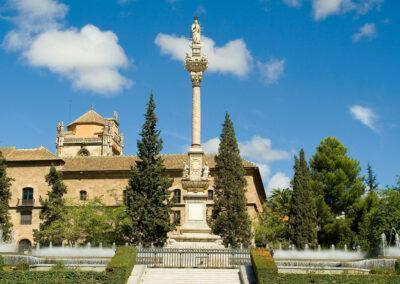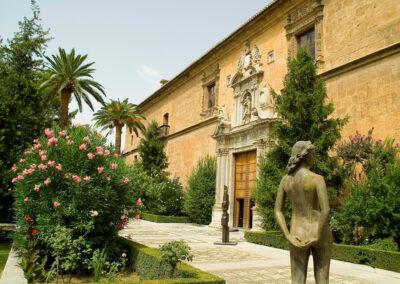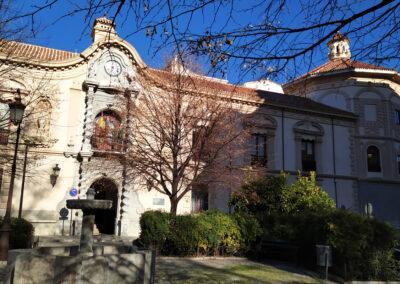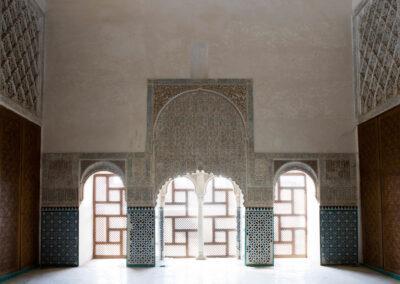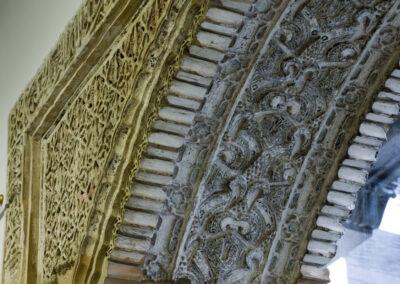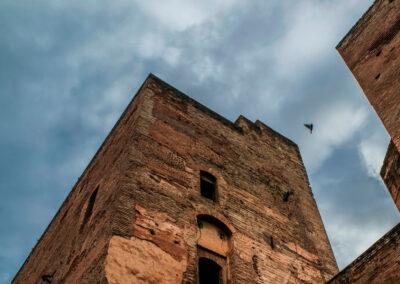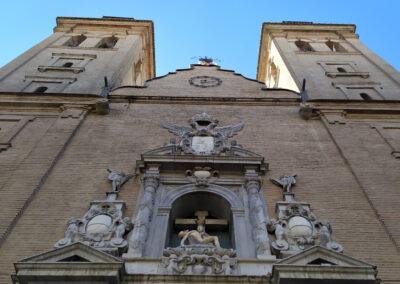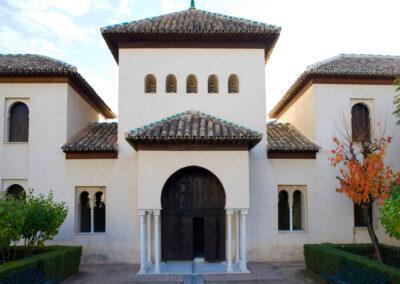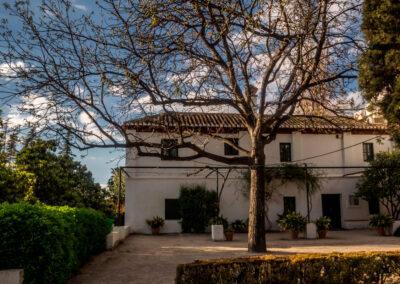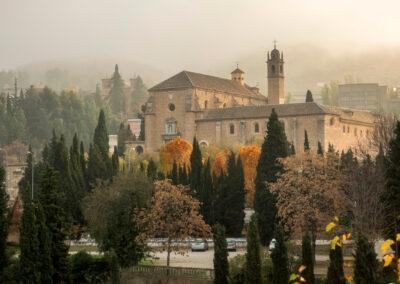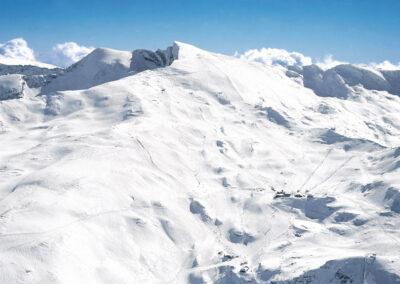Walks through Granada
You should see the Alhambra and Granada. It is like fairy work;it is magic, glory, love; like nothingknown before.
François-René de Chateaubriand
Its privileged location, between the Mediterranean coast and Upper Guadalquivir, between the Levant and Lower Andalusia, a crossroads of historical byways, its particular landscape, the contrast between the peaks of Sierra Nevada and the sub-tropical areas on the coast —all this and the different civilizations— have crystallized in the present day city of Granada.
The settlement of people in the region of Granada dates from ancient times. There was already a settlement in this area during the Bronze Age, on the hills of Granada, in the Albayzin and almost certainly on the hill of El Mauror (Torres Bermejas).
From the 6th century BC the Iberian people are mentioned, who in the province of Granada are called Bastetani, after the town of Basti –current Baza. The Iberian village of Albayzin, Ilbyr, Elbyrge or Illiberis was possibly one of the important settlements in this part of the province. Its structure was hardly modified upon the arrival of the Romans, but the political situation, as well as the architecture did change. The town belonged to the Roman province of Hispania Ulterior, being among the 27 towns with Latin Law.
Granada is universally associated with the splendour of al-Andalus. From 711 onwards, the first Muslim incursions found a village outside the walls of Illiberis, called Garnata al Yahud, city of the Jews, which was to give its name to all the city.
Removal of the capital to its primitive location took place in the disturbed 11th century, between the Darro and the Genil rivers and it received the name of Hisn Garnata. The battle of Las Navas de Tolosa in 1212 marked the end of Almohad rule, so that the territory of al-Andalus was reduced to the area of Granada, where the Nasrid dynasty came to power, in the person of Muhammad Ibn Yussuf Ibn Nasr, emir of Arjona, in 1232. He soon took control of Jaén and Porcuna and gained recognition from Granada, where he installed his capital, thereafter annexing Almería and Málaga. Under Yusuf I in 1333 and after, with Muhammad V, the Kingdom of Granada reached the pinnacle of power and that is when the Alhambra and Generalife are built. The war which began in 1485 would lead to the Kingdom’s fall.
Ferdinand and Isabella took the city in 1492, thus, the splendour of al-Andalus came to an end.
1. The Alhambra and Generalife
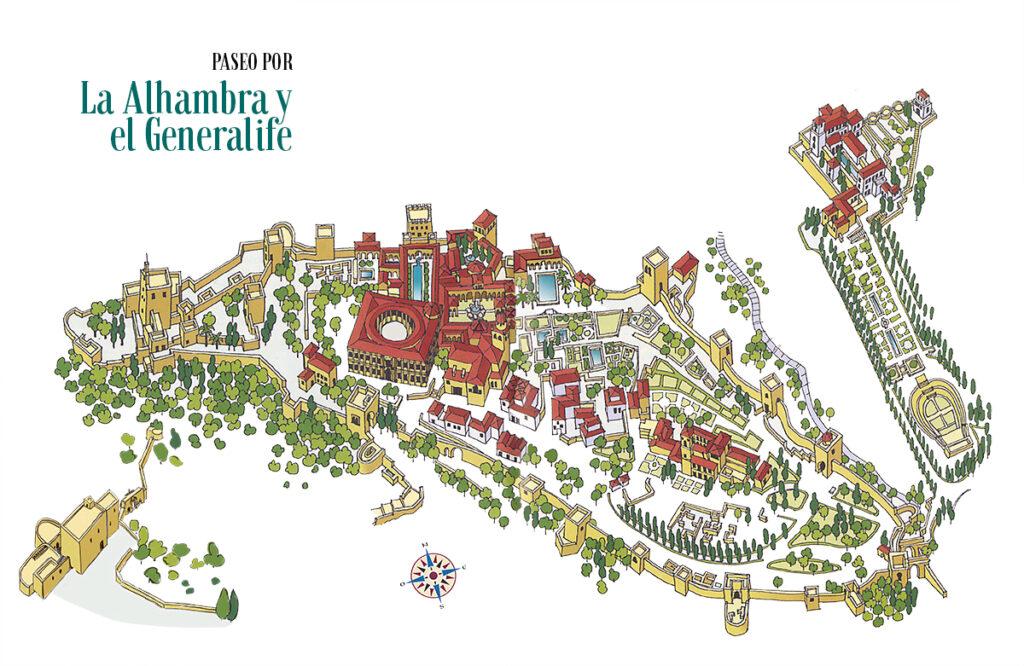
Download plan for this walk
he access to one of the most beautiful buildings in the world can be gained along Cuesta de los Gomérez that starts in Plaza Nueva and climbs sharply through small shops up to Las Granadas gate. This Renaissance entrance, by Pedro Machuca, marks the limits of the grounds of the Alhambra (the Red One), on the Sabika hill, opposite the Albayzin district and the Alcazaba Qadima. When the Nasrids set up their kingdom in the 13th century, the founder decided that his residence was to be in the same place as the Alcazaba. This fortress was rebuilt and the construction of the palace begun, to be continued by his descendants. Yusuf I and his son Muhammad V are responsible for most of the buildings that can be visited nowadays. After going through Las Granadas gate, we walk along the wood of what was the Alhambra citadel. Torres Bermejas are located on the hill opposite, a fortress rebuilt around 1240 by Alhamar, the Nasrid founder. These slopes lead to the Pillar of Charles V among trees and irrigation ditches and to La Justicia gate, from the time of Yusuf I, the principal entrance in the wall where Fatima’s hand and a key are to be seen, frequent symbols on Nasrid buildings.
At the end of a street we arrive to El Vino –wine- gate. Passing through it we reach Los Aljibes square, ante-room for visitors to the Alhambra. To one side is Charles V’s palace, a solid Renaissance building begun in 1527 by Pedro Machuca, with an imposing bossed façade. It houses the Alhambra Museum and the Fine Arts Museum.
The Alcazaba (fortress) stands on the other side, on the higher part of the Sabika hill. A wall can be appreciated with three large towers: Adarguero to the south, Quebrada in the middle and the Keep on the north side, in front of the circular 16th-century tower of El Cubo. To the south of the Alcazaba, beside the Tower of La Sultana we discover the 17th-century Garden of Los Adarves, under the Tower of La Vela, the Alhambra watchtower. An 11th-century door to the Alcazaba stands below the watchtower. Las Armas gate is the most handsome of the four outer Gates.
The royal Nasrid residence was at the heart of the Alhambra. There was the part used for public events and government —the Palace of Comares— and the private side or harem, the Palace of Los Leones. Access to these palaces is gained through the courtyards of la Madrasa de los Príncipes and Machuca. There is an angled door into El Mexuar(Council Room). Divided by a courtyard, there is a marvellous view of the Palace of Comares, that stretches around the Patio de la Alberca or Los Arrayanes. On the north side there is a gallery with seven arches opening on to the hall of la Barca, the Muslim baraka, a divine blessing for privileged beings. An anteroom stands before the Hall of Comares or Hall of Ambassadors, which one should imagine covered with carpets and wall hangings and cushions on a coloured floor. The palace of Los Leones is built around another marvellous courtyard that has 124 pillars with different capitals and a fountain guarded by 12 marble lions that might well date from 11th century. The central halls of the Abencerrajes and Dos Hermanas share a similar distribution, with extraordinarily beautiful stalactite or honeycomb vaults. The original Hall of Los Mocárabes (which is how stalactite or honeycomb work is known in Spanish) was destroyed when an ammunition dump nearby blew up in 1590. Other interconnected rooms are Los Ajimeces, with the Lindaraja viewpoint—al-ain dar Aixa, “the eye of Aixa’s room”— and the Hall of Los Reyes on the east side. The Royal Baths are to be found between the two palaces. El Partal garden is also on the east side, surrounded by a wall with several towers: Los Picos, El Cadí, La Cautiva, Las Infantas…
The palace and gardens of the Generalifestand in front of the Alhambra, slightly higher up. Its name, Garden of the Generalife could come from —Jannat al-Arif, “Garden of the Builder”—. Entry to the central building is through a courtyard and inside there are the famous Courtyard of la Acequia, Sala Regia, the gardens and the singular Escalera del Agua (water stairs)..
2. From the Elvira Gateway to San Nicolás
Ibn al-Raia
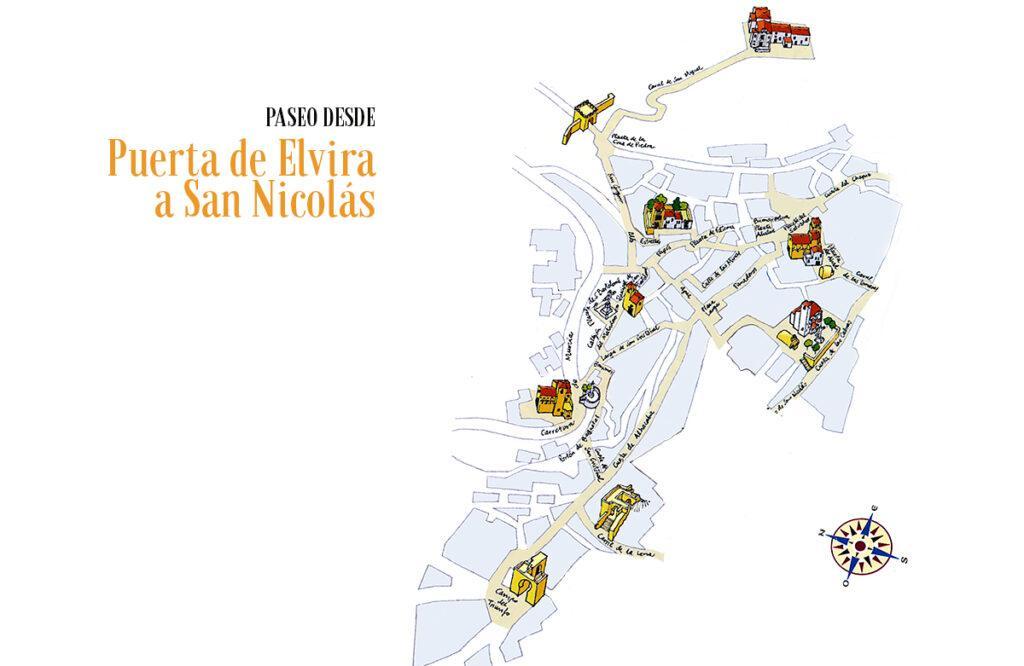
Download plan for this walk
A walk in Granada could begin in one of the principal accesses to the oldest parts of the walled city. The monumental Elvira Gateway, already mentioned in the 9th century, though most of what can be seen today dates from the 11th century, was probably called Elvira (Bab Ilbira) after the no-longer-existing town of Madinat Ilbira, predecessor to Granada, located at the foot of Elvira mountain range. A few steps further is Cuesta de Alhacaba, on whose side there are remains of the oldest part of the Zirid walled enclosure: here are sections of wall with large towers and the Monaita Gate, with an angular passageway under horseshoe vaults that was the entrance to what was known as the Old Alcazaba, the primary centre of the Muslim city.
Calle Larga de San Cristóbal street starts nearly at the end of the slope, on the left, leading to the viewpoint and the church of San Cristóbal, a marvellous place from where to get an excellent view of the whole town. Most of the Albayzin’s Xarea district is visible, spread out in different levels on one of the highest hills of Granada. The wall continues until it reaches the Sacromonte hill. Now the Albayzin quarter is before us —al-Bayyazin, district of the falconers-, heart of the Muslim town, a network of twisted narrow streets, with many churches built over old mosques and little squares and fountains. There are many cármenes(andalusi houses with garden) here, such as that of Los Mascarones with gardens, paintings and statues, and the Carmen de las Tres Estrellas.
Beyond San Cristóbal is San Bartolomé, a church with an imposing minaret converted into belfry, and a cistern from the times of al-Andalus beside it. The plain Mudéjar church was built over a mosque in 1554. Through the Fajalauza gate, the picturesque Carril de San Miguel climbs up to its hermitage where, once more, there is a magnificent view.
The walk continues along nooks and crannies through the little squares of Fátima and Aliatar, up to the Church of El Salvador. Its courtyard standing behind severe whitewashed walls, has a gallery with pointed arches rather typical of a courtyard of ablutions and it is the sign that the principal mosque of the Albayzin stood here. On the upper part of this sector, we come upon the wide square of the church of San Nicolás, built over a mosque, and a Nasrid cistern. What is perhaps the most famous view of Granada is seen from here –the Alhambra at the front with Sierra Nevada in the background.
3. From the Albayzin to Plaza Nueva
Retracing our footsteps, we will eventually come to another landmark, the monumental palace of Dar al-Horra. It dates from the second half of the 15th century, built by the Nasrids around a courtyard with a central pool, and galleries all around, from which one enters rooms leading off one from the other. Its name —dar al-Horra, house of the honest lady— refers to the noble lineage of the inhabitants. It was the home of Fatima, King Boabdil’s mother. Beside the palace are the convent of Santa Isabel la Real, established by Ferdinand and Isabella and later built between 1574 and 1592. There is another small square a little bit further, the delightful plaza of San Miguel Bajo, with the church of the same name, a synthesis of Mudéjar and Renaissance, with a 13th-century cistern by the wall. Below, La Lona viewpoint provides a view of a large part of the city, as well as of the fertile plains.
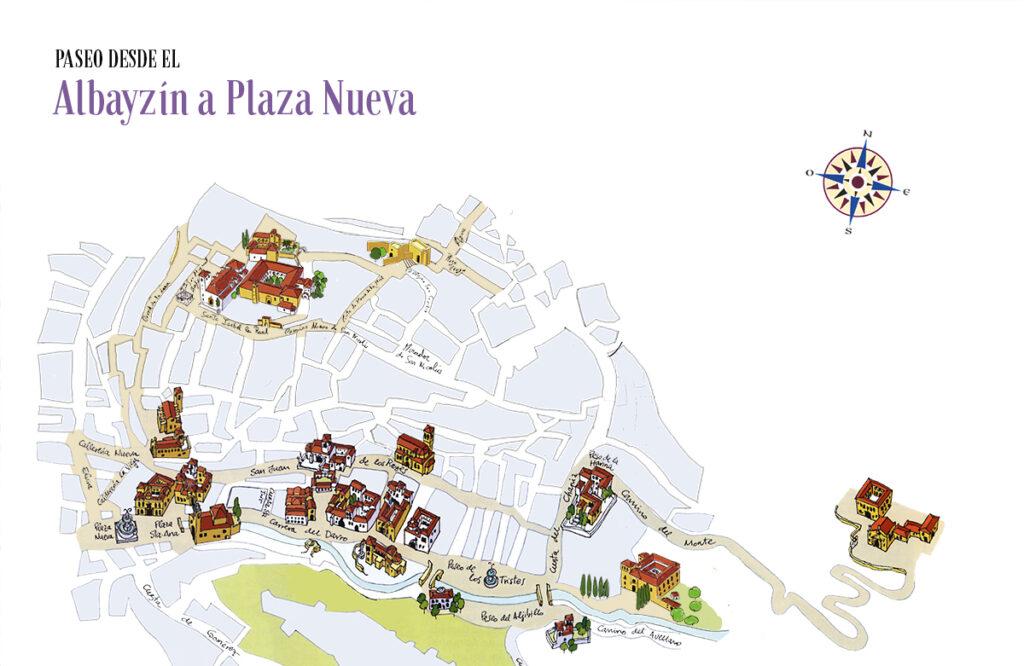
Download plan for this walk
From the top of the Albayzin quarter, the slopes reach down to the side streets which, forming rings, circle the hill in its lower part. Calderería Nueva street is brimful of shops and coffee shops and has a very oriental air; it ends in Elvira street which, despite its narrowness is full of people, and connects Elvira Gate and the neighbourhood of Plaza Nueva. Half way up, San Juan de los Reyes street zigzags upwards, one of the main streets of al-Andalus times and still busy today. There, the old hospital and later mint —the Maristan, founded by Muhammad V in 1367— are seen, as well as several religious buildings such as the churches of San José and San Juan de los Reyes, in the Gothic-Mudéjar style that still preserves the 13th-century minaret of the mosque over which it was built. On the other side of the hill, the north face, Cuesta del Chapizstreet descends steeply to the Darro river. The river front has many remarkable houses, such as Casa del Chapiz, now the School for Arabic Studies, and the Palace of Los Córdova. The way to Sacromonte starts around these parts, winding up to the hermitage of El Santo Sepulcro and the collegiate church of San Cecilio, patron saint of Granada. Hidden nearby is the district of cave dwellings which was so attractive for the romantics.
The course of the Darro river runs along Paseo de los Tristes (sad people promenade) because funerals used to come along this road, and its extension, Carrera del Darro, leading to Plaza Nueva. Here there are several places of interest; the Convent of San Bernardo, Casa de Castril —with a remarkable Plateresque façade that houses today the Archaeological Museum— in front of the church of San Pedro and San Pablo. Then we find the convent of Santa Catalina de Zafraand the restored Casa de Zafra, from the times of al-Andalus. On the opposite side we have the abutment of Los Tableros Gateway —wrongly called Cadí Arch— and, lastly El Bañuelo, the old Moorish baths of El Nogal —hammam al-Yawza— lodged in the house number 31, an 11th-century building from the times of the Zirid dynasty, where the different rooms have vaulted ceilings typical of this kind of establishment which, in turn, is characteristic of the culture of the times of al-Andalus.
Carrera del Darroends where Plaza Santa Ana and Plaza Nueva meet. The Real Chancillería (royal chancery) —a Renaissance masterpiece— overlooks the whole open space where we can also admire the church of Santa Ana, which replaced the Almanzora mosque in 1537; the church shows a classical doorway, a handsome Mudejar tower and a fine ceiling inside.
4. Between Puerta Real and the Gardens of El Triunfo
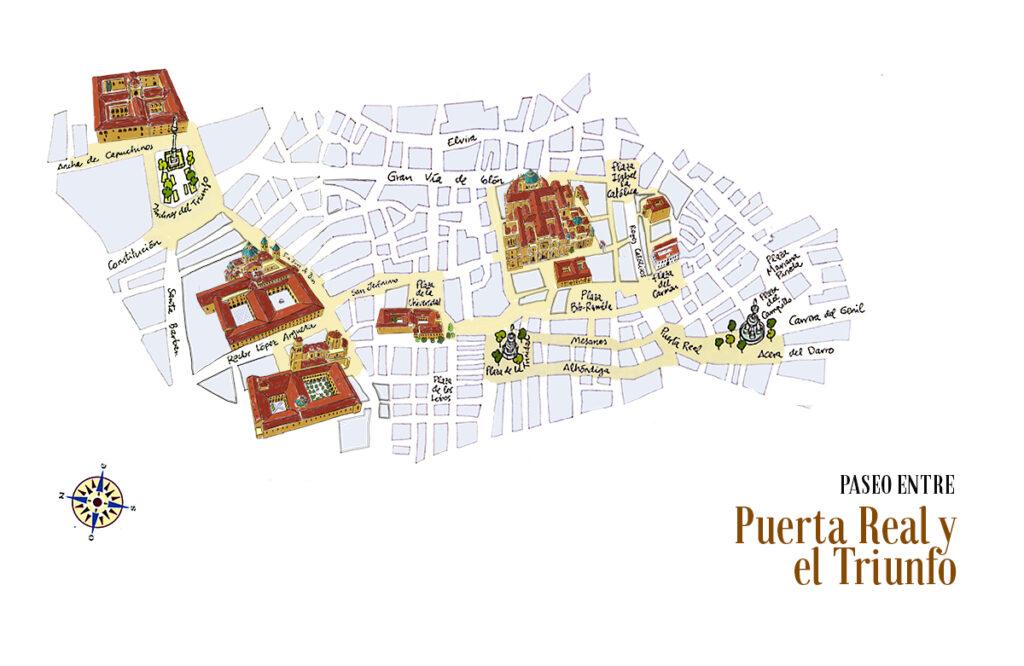
Download plan for this walk
Between these two places, the visitor can witness a spectacular mixture of cultures. Al-Andalus, Renaissance and Baroque combine to give us a view of art and history. Near El Carmen square, where the Town Hall is settled, stands Corral del Carbón (14th century) and headquarter of The Andalusian Public Foundation El legado andalusí. The façade –recently restored- shows a pointed horseshoe arch that opens on to a courtyard with paving stones and arcades and large aisles intended for the rest of travellers and merchants.
Across Reyes Católicos street, Zacatin street opens up right in the centre of Granada. Its meaning is clothes market, and all sort of stands were established here: second-hand clothes merchants, silversmiths, shoe shops, dyers and leather workmen. The street comes out in Bib-Rambla square, where all the Muslim fishmongers and butchers plied their trade. The Christians used this space for official events, and it was also the customs for spices and textiles and where the fairs were held.
The Archbishop’s Palace backs on to this square, and so does the Alcaiceria, once the silk exchange and now the market for local crafts. A fire burnt it all down in 1843, but it was rebuilt later on. The Madrasa, school of Arabic studies, stood in Oficios street. It was founded by Yusuf I in 1349 and is one of the loveliest buildings in Granada. . Isabella and Ferdinand used it as the Chapter house from 1500 and there is still the oratory of the Muslim building.
The Royal Chapel stands in front, in late Gothic style, and was built by Ferdinand and Isabella, who wished to be buried in Granada and there they have lain side by side, to be joined later by their daughter Juana la Loca and her husband Philippe le Bel. The chapel is attached to the Cathedral and the Lonja de los Mercaderes. The voluminous adjacent Cathedral was built at the express wish of Queen Elizabeth where the Great Mosque was; later, Church of Santa María de la O. The Cathedral’s building begun on March 25, 1523 and stands wall to wall with the Royal Chapel; it is Diego de Siloé’s huge Renaissance masterpiece and it was not finished until 1667; the main façade, Baroque, is due to Alonso Cano. It is a masterpiece of Spanish classicism with a main Baroque façade by Alonso Cano and a Renaissance-style interior on a Gothic plan, with a main chapel by Diego de Siloé.
Other notable buildings in this sector are the old University, commissioned by Charles V in 1526 and the church of Saints Justo y Pastor, the old Majadalbecy mosque in Encarnación square; begun in 1575, it is one of the most opulent churches in Granada. The monastery and church of San Jerónimo stand in the direction of Gran Capitán Street; building started in 1496 and it consists of two courtyards, one Gothic and other Renaissance. A short distance away is the hospitol and church of San Juan de Dios, which has a magnificent Baroque cloister. Campo del Triunfo’s gardens open up on the other side of Gran Vía, where the imposing Hospital Real can be seen –nowadays the University of Granada’s main building.
5. From Campillo Bajo to Alcázar Genil
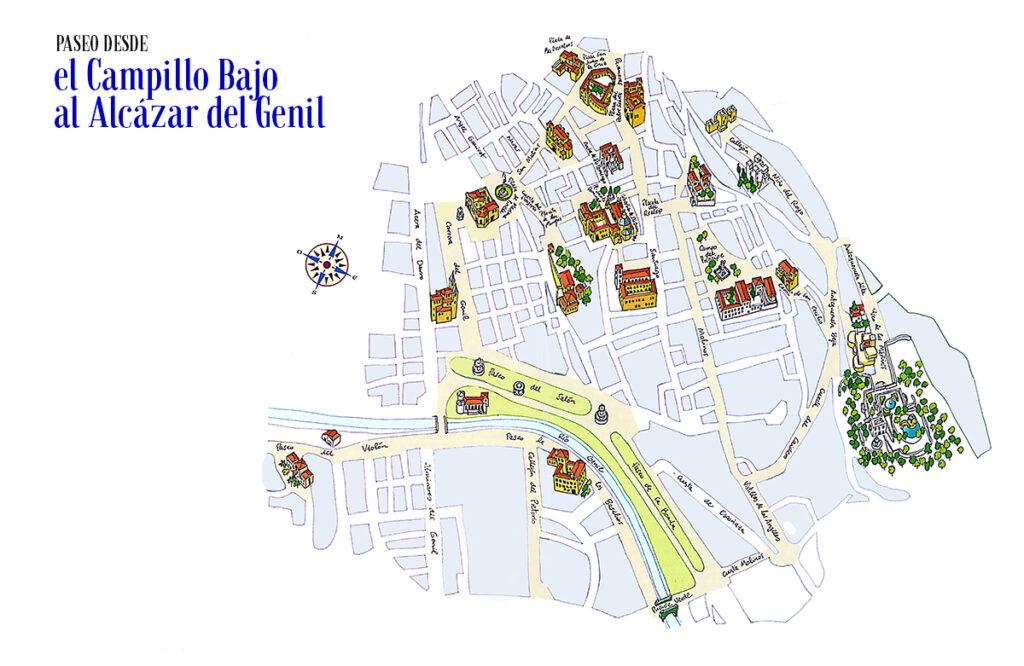
Download plan for this walk
From Campillo Bajo square in the center of the town, , with the ancient palace of Bibataubín, dating from 1752 and the nearby Cuarto Real de Santo Domingo, a 13th-century Nasrid building, the way leads upwards through characteristic quarters such as El Realejo, between Campo del Príncipe and the Genil river; La Antequeruela, behind the church of San Cecilio, until the districts of El Mauror or La Judería are reached of the Torres Bermejas.
Near San Juan de la Cruz square we will find convent of San Francisco, headquarters to the General Captaincy; the house of Gran Capitán, which used to be a 17th-century Carmelite convent; Casa de los Tiros, one of the most impressive buildings in the city, whose name comes from the muskets (tiros) on the façade, the drawing room being still part of the original building, it is known as Cuadra Dorada. Also worth mentioning is the 16th-century House of Padre Suárez (16th century) and Casa de los Girones in Ancha de Santo Domingo street, which may have been the palace of King Boabdil’s sister.
After the Christian reconquest, a great number of religious foundations were established in the city, such as Santa Cruz la Real, Comendadoras de Santiago and Santa Catalina de Siena –the latter in El Realejo square. Las Alfarerías gate used to be here, entrance to the potters’ district of the town. Campo del Principe was a place where the royal vegetable gardens flourished and La Antequeruelagrew up when the Muslims were expelled from Antequera after its reconquest in 1410. The composer Manuel de Falla lived in one of the carmenes here, turned into a museum. The Manuel de Falla Auditorium is also here and so is the Carmen of the Rodríguez Acosta Foundation, with a valuable art collection. The Mauror neighbourhood, or Jewry, is below Torres Bermejas.
On the banks of the Genil River, there are pleasant walks, such as Paseos de la Bomba and El Salón and, on the other side, Los Basilios, San Sebastián and Ribera del Violón, where King Boabdil handed over the keys of Granada to Ferdinand and Isabella. There is also the hermitage of San Sebastián not far away, in what used to be a morabito (kind of Muslim hermitage). Lastly, at the beginning of Camino de Ronda street we find theAlcázar del Genil, which used to be a pavilion belonging to Boabdil’s mother, covered by a lace framework, friezes ornamented with muqarnas and lateral rooms. Outside, there used to be a pond where naval battles were simulated.
6. Surroundings
The most special trip is the one that leads to the summits of Sierra Nevada -called Yebel Solair by the Arabs-, with the Veleta and Mulhacen peaks, 3,448 m, top of the Iberian Peninsula. The ascent to Sierra Nevada overcomes a height difference of 680 to 3,200 m. 36 km away from Granada the visitor can enjoy the ski resort of Sierra Nevada, that includes Pradollano complex, a paradise for mountain sports.
The Granada Walks of El legado andalusí are recommended in the Granada Guide by
![]()
ENJOY OUR
DECEMBER programme
ALONG WITH OUR PARTNER COMPANIES







